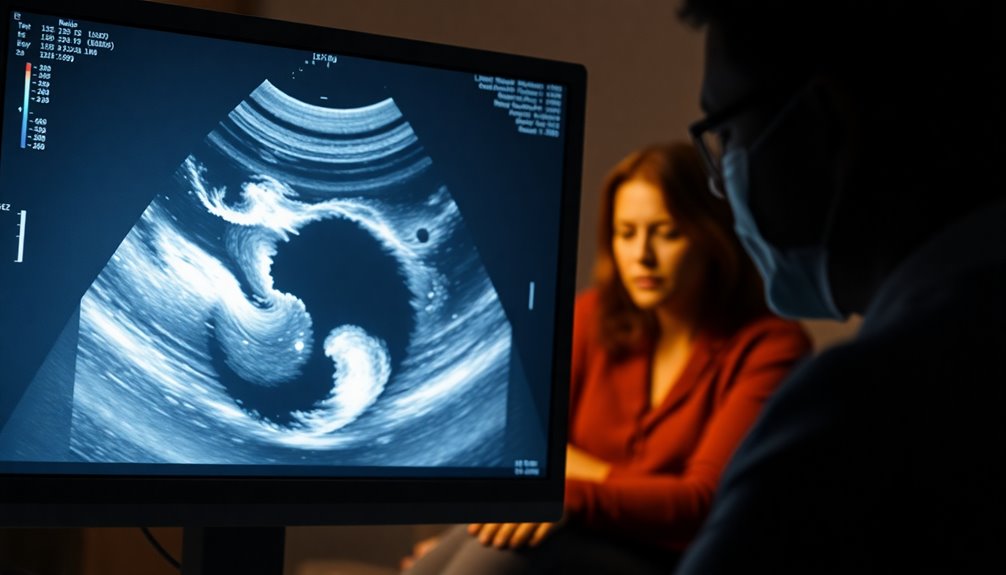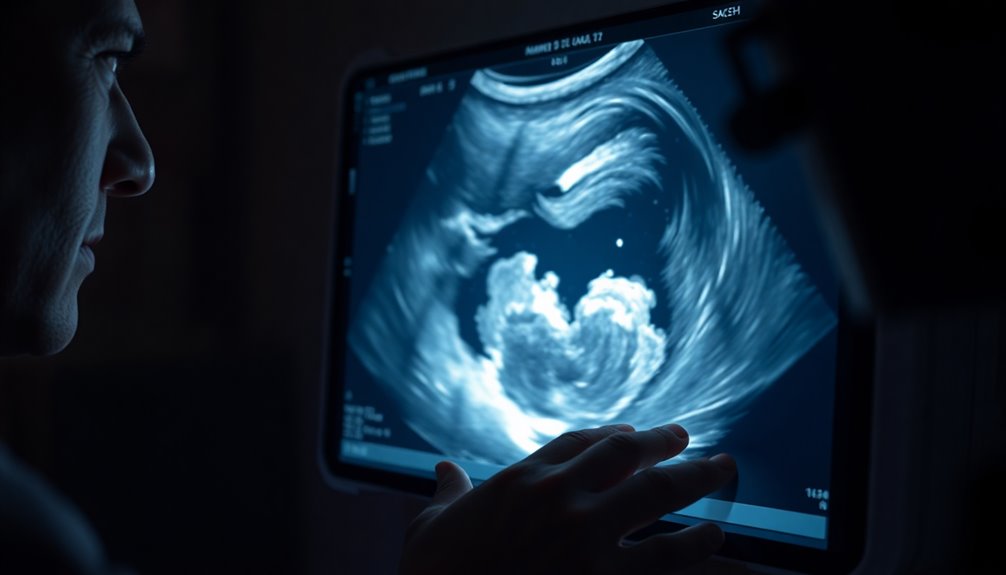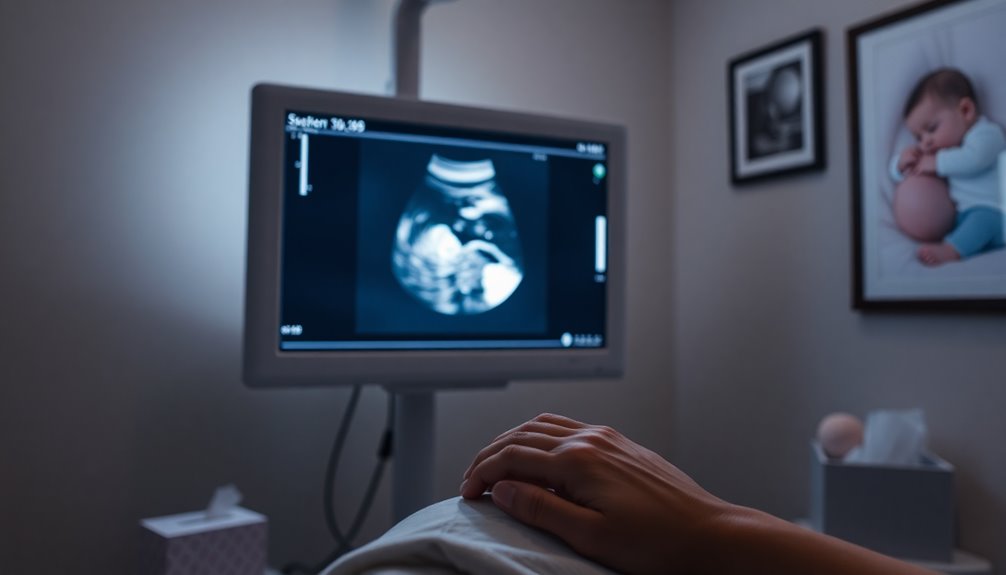It's shocking not to see a gestational sac on your ultrasound, especially since it usually appears by five weeks when hCG levels hit around 1500 to 2000. There can be several reasons for this, like being too early in the pregnancy or potential complications like an ectopic pregnancy. If the sac isn't visible, your healthcare provider will likely recommend follow-up ultrasounds and monitoring. Keep going to learn more about what this could mean for your pregnancy journey.
Key Takeaways
- The gestational sac is usually visible by five weeks; absence may indicate early pregnancy or timing issues.
- If no sac is seen, follow-up ultrasounds and hCG monitoring are essential for accurate diagnosis.
- Ectopic pregnancy or miscarriage could be possible causes; seek immediate medical evaluation if experiencing severe symptoms.
- Emotional support from healthcare providers is crucial, as anxiety is common when the gestational sac is not detected.
- Absence of a sac does not always mean a non-viable pregnancy; further investigation is necessary to determine viability.
When Is a Gestational Sac Visible?

When can you expect to see a gestational sac on an ultrasound? Typically, you'll see it by five weeks gestational age, though it might be detected as early as four weeks.
At this stage, the gestational sac measures about 2 to 3 millimeters and becomes visible when hCG levels reach between 1500 to 2000.
By five-and-a-half to six weeks, a visible yolk sac usually appears within the gestational sac.
If no gestational sac is seen by five weeks, a follow-up ultrasound is recommended to evaluate the pregnancy's status.
The absence of a visible gestational sac can indicate early pregnancy, ectopic pregnancy, or even miscarriage, making it essential to adhere to diagnostic criteria for proper assessment during the first trimester.
Common Reasons for No Gestational Sac

There are several common reasons you mightn't see a gestational sac on an ultrasound. One reason could be that you're in early pregnancy; the sac typically appears by five weeks when hCG levels hit 1500 to 2000.
If the ultrasound timing is off, you might miss it entirely, as it can sometimes be detected as early as four weeks.
Another concern is ectopic pregnancy, which requires immediate medical evaluation. Additionally, if you're experiencing symptoms like vaginal bleeding or cramping, the absence of a gestational sac could indicate a miscarriage.
Ectopic pregnancy necessitates urgent medical attention, especially if you experience vaginal bleeding or cramping.
If a follow-up ultrasound doesn't show a gestational sac by five weeks, further investigation is necessary for an accurate diagnosis and to understand your pregnancy's status.
What To Do If There's No Gestational Sac

Not spotting a gestational sac on ultrasound can understandably raise concerns about your pregnancy. If no sac is visible by five weeks gestation, your healthcare provider will likely recommend a follow-up ultrasound to clarify the situation.
The absence of a gestational sac might indicate early pregnancy, ectopic pregnancy, or a potential miscarriage. It's essential to monitor your hCG levels through blood tests, as this can help determine the pregnancy location and viability.
While it's normal to feel anxiety during this time, lean on your healthcare providers for support. Also, avoid traveling until your pregnancy location is confirmed, especially if an ectopic pregnancy is suspected, as this could complicate diagnosis and management.
Understanding the Yolk Sac and Its Importance

Understanding the yolk sac's significance in early pregnancy is vital, as it plays an important role in nourishing the developing embryo before the placenta takes over.
During an ultrasound, the yolk sac is typically the first structure visible within the gestational sac, usually detectable around 4.5 to 5 weeks of gestation.
Here are key aspects of the yolk sac:
- It provides nourishment to the embryo until the placenta forms.
- A normal yolk sac should appear when the mean sac measurement reaches at least 20 mm.
- Absence of the yolk sac in a 25 mm gestational sac may indicate a miscarriage.
- An abnormal yolk shape can signal potential issues with pregnancy viability.
Recognizing these factors is vital for monitoring early pregnancy health.
Next Steps and Seeking Support

If you find yourself facing uncertainty after an ultrasound shows no visible gestational sac, it's important to know what steps to take next.
Follow-up ultrasounds and hCG monitoring are essential to clarify your pregnancy status and detect any changes. Remember, the absence of a gestational sac doesn't necessarily mean a non-viable pregnancy; it could be too early for accurate detection.
Reach out to your healthcare professionals for emotional support and guidance during this anxious time.
However, if you experience severe pain, vaginal bleeding, or fainting, seek urgent evaluation immediately.
Regular check-ups may take weeks, so understanding the process and leaning on your support network will help you navigate this challenging situation more smoothly.
Frequently Asked Questions
Why Is My Gestational Sac Not Showing up on Ultrasound?
If your gestational sac isn't showing up on the ultrasound, it could be due to a few reasons.
You might be earlier in your pregnancy than expected, or the timing of the ultrasound mightn't align with your hCG levels.
There's also a possibility of an ectopic pregnancy or miscarriage.
It's important to follow up with your healthcare provider, monitor hCG levels, and get emotional support during this uncertain time.
How Late Can Gestational Sac Be Seen on Ultrasound?
You can typically see a gestational sac by around five weeks of pregnancy, but it may not be visible until six weeks or later in some cases.
If you haven't seen it by the sixth week, it's important to follow up with your healthcare provider. They might recommend additional ultrasounds and monitor your hCG levels to assess the situation and guarantee everything's progressing as it should be.
Why Was My Urine Test Positive but No Sac in Ultrasound?
If your urine test is positive but no gestational sac appears on the ultrasound, it could be due to several factors.
It might be too early in your pregnancy for the sac to be visible, especially if your hCG levels haven't reached the necessary threshold.
Alternatively, there's a chance of a miscalculation in gestational age or a more serious issue like an ectopic pregnancy.
Follow-up ultrasounds and hCG monitoring are essential for clarity.
Why Is Nothing Visible on My Ultrasound at 6 Weeks?
At 6 weeks, you'd expect to see a gestational sac, yet nothing's visible on your ultrasound.
This contrast can be concerning, but it doesn't always mean something's wrong. Your pregnancy might just be too early, especially if your menstrual cycles are irregular.
Lower hCG levels could also play a role. Follow-up ultrasounds are often recommended to monitor the situation, as there's still a chance for a viable pregnancy.
Conclusion
If you don't see a gestational sac on your ultrasound, it can be concerning, but remember that about 20% of early pregnancies might not show one right away. It's essential to stay calm and consult your healthcare provider for guidance. They can help you understand the next steps and what to expect. Always seek support from friends or family during this time, as sharing your feelings can make a significant difference in your experience.









